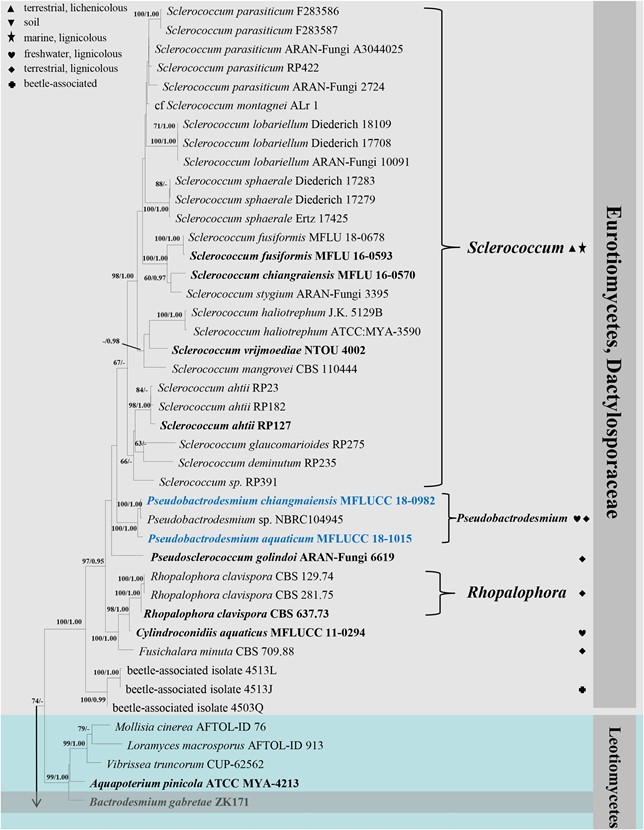Pseudobactrodesmium H. Zhang, W. Dong & K. D. Hyde, gen. nov.
Index Fungorum number: IF557247; Facesoffungi number: FoF07525
Etymology: in reference to bactrodesmium-like morphology
Saprobic on submerged wood in freshwater or decaying wood in terrestrial habitats.
Sexual morph: Undetermined.
Asexual morph: Hyphomycetous. Colonies sporodochial, superficial, effuse, gregarious or scattered, brown, punctiform. Mycelium mostly immersed, composed of septate, branched, hyaline hyphae. Conidiophores macronematous, mononematous, fasciculate, compact, erect, subcylindrical, septate, usually unbranched, brown, smooth. Conidiogenous cells enteroblastic, with inconspicuous proliferations, integrated, terminal, subcylindrical, pale brown. Conidia acrogenous, solitary, dry, thin-walled, smooth-walled, clavate, subcylindrical, narrowly fusiform or subulate, euseptate, phragmoseptate, brown, often enveloped by a hyaline, spherical sheath at the apex. Apical cells elongated, tapering gradually toward the apex, with globose tuberculate apex.
Type species: Pseudobactrodesmium aquaticum W. Dong, H. Zhang & K.D. Hyde
Notes: – Pseudobactrodesmium is characterized by enteroblastic conidiogenous cells and subulate or fusiform, evenly pigmented conidia with a tapering apical cell. In contrast, Bactrodesmium as typified by B. abruptum is quite distinct in producing holoblastic conidiogenous cells and clavate to fusiform, unevenly colored conidia which are mid or dark brown at the upper part and becoming paler toward the basal cell, 3- to multi-transversely septate, with very dark bands at the septa, the upper one thick and black, unequal cells, the penultimate cell much longer than any of the others (Ellis, 1971). Pseudobactrodesmium nests well within the family Dactylosporaceae in our phylogenetic tree of the combined sequence dataset (Figure 1). The unique combination of morphological characters of Pseudobactrodesmium stands apart from other existing genera in this family (Hawksworth, 1975; Ellis, 1976; Jones et al., 1999; Réblová et al., 2016; Yu et al., 2018; Olariaga et al., 2019). Pseudobactrodesmium is morphologically similar to a few dematiaceous hyphomycetous genera with long or short, septate conidia, e.g., Bactrodesmiastrum (Holubová-Jechová, 1984), Bactrodesmium (Ellis, 1971, 1976), Digitodesmium (Boonmee et al., 2016), Distoseptispora (Su et al., 2016), Scolecostigmina

FIGURE 1 | Continued

FIGURE 1 | RAxML tree generated from combined LSU, SSU, ITS, and RPB2 sequence data. Bootstrap support values for maximum likelihood (the first value) equal to or greater than 60% and Bayesian posterior probabilities (the second value) equal to or greater than 0.95 are given above or below the nodes. The tree is rooted to Cheilymenia stercorea (AFTOL 148) (Pezizomycetes). The ex-type strains are indicated in bold and newly generated sequences are indicated in blue. Four bactrodesmium-like species are highlighted in gray background. Symbols after generic names in Eurotiomycetes indicate the habitats of taxa as explained in the phylogram.
Species
